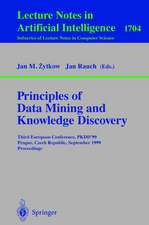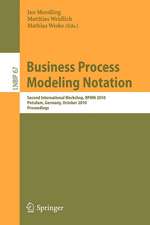Business Process Management: Concepts, Languages, Architectures
Autor Mathias Weskeen Limba Engleză Hardback – 15 iul 2024
The 4th edition of his book contains significant updates, including a new section on directly follows graphs that play a crucial role in process mining. In addition, the core of declarative process modeling is introduced. The increasingly important role of data in business processes is addressed by a new section on data objects and data models in the data and decision chapter. To cover a recent trend in process automation, the enterprise systems architecture chapter now includes a section on robotic process automation.
Mathias Weske argues that all communities involved need to have a common understanding of the different aspects of business process management. Hence his textbook is ideally suited for classes on business process management, information systems architecture, and workflow management alike. The accompanying website www.bpm-book.com contains further information and additional teaching material.
| Toate formatele și edițiile | Preț | Express |
|---|---|---|
| Paperback (2) | 339.34 lei 6-8 săpt. | |
| Springer Berlin, Heidelberg – 15 aug 2020 | 339.34 lei 6-8 săpt. | |
| Springer – 10 iun 2014 | 437.85 lei 38-44 zile | |
| Hardback (2) | 421.23 lei 3-5 săpt. | +36.62 lei 4-10 zile |
| Springer Berlin, Heidelberg – 15 iul 2024 | 421.23 lei 3-5 săpt. | +36.62 lei 4-10 zile |
| Springer Berlin, Heidelberg – 4 mai 2012 | 516.02 lei 6-8 săpt. |
Preț: 421.23 lei
Preț vechi: 484.17 lei
-13% Nou
80.61€ • 83.85$ • 66.55£
Carte disponibilă
Livrare economică 24 martie-07 aprilie
Livrare express 07-13 martie pentru 46.61 lei
Specificații
ISBN-10: 3662695170
Pagini: 450
Ilustrații: XIX, 455 p.
Dimensiuni: 155 x 235 x 34 mm
Greutate: 0.84 kg
Ediția:Fourth Edition 2024
Editura: Springer Berlin, Heidelberg
Colecția Springer
Locul publicării:Berlin, Heidelberg, Germany
Cuprins
Notă biografică
Textul de pe ultima copertă
The 4th edition of his book contains significant updates, including a new section on directly follows graphs that play a crucial role in process mining. In addition, the core of declarative process modeling is introduced. The increasingly important role of data in business processes is addressed by a new section on data objects and data models in the data and decision chapter. To cover a recent trend in process automation, the enterprise systems architecture chapter now includes a section on robotic process automation.
Mathias Weske argues that all communities involved need to have a common understanding of the different aspects of business process management. Hence his textbook is ideally suited for classes on business process management, information systems architecture, and workflow management alike. The accompanying website www.bpm-book.com contains further information and additional teaching material.
Caracteristici
Recenzii
“The subject Business process management is of interest to professional in business administration and computer science. … The author opines that both the communities need to have a common understanding of the different aspects of business process management. In this context, he details the complete business process lifecycle from the modeling phase to process enactment and improvement, taking into account all different stakeholders involved. … This is an ideal text book for the students for CSE & business administration.” (CSI eNewsletter, Vol. 3 (10), November, 2012)
Descriere
Business process management is usually treated from two different perspectives: business administration and computer science. While business administration professionals tend to consider information technology as a subordinate aspect in business process management for experts to handle, by contrast computer science professionals often consider business goals and organizational regulations as terms that do not deserve much thought but require the appropriate level of abstraction.
Matthias Weske argues that all communities involved need to have a common understanding of the different aspects of business process management. To this end, he details the complete business process lifecycle from the modeling phase to process enactment and improvement, taking into account all different stakeholders involved. After starting with a presentation of general foundations and abstraction models, he explains concepts like process orchestrations and choreographies, as well as process properties and data dependencies. Finally, he presents both traditional and advanced business process management architectures, covering, for example, workflow management systems, service-oriented architectures, and data-driven approaches. In addition, he shows how standards like WfMC, SOAP, WSDL, and BPEL fit into the picture.
This textbook is ideally suited for classes on business process management, information systems architecture, and workflow management. This 2nd edition contains major updates on BPMN Version 2 process orchestration and process choreographies, and the chapter on BPM methodologies has been completely rewritten. The accompanying website www.bpm-book.com contains further information and additional teaching material.



















